Archimedes was fascinated with calculating the areas of various shapes - in other words, the amount of space enclosed by the shape. He used a process that has come to be known as the method of exhaustion, which used smaller and smaller shapes, the areas of which could be calculated exactly, to fill an irregular region and thereby obtain closer and closer approximations to the total area. In this process, an area bounded by curves is filled with rectangles, triangles, and shapes with exact area formulas. These areas are then summed to approximate the area of the curved region.
In this section, we develop techniques to approximate the area between a curve, defined by a function \(f(x)\), and the \(x\)-axis on a closed interval \([a,b]\). Like Archimedes, we first approximate the area under the curve using shapes of known area (namely, rectangles). By using smaller and smaller rectangles, we get closer and closer approximations to the area. Taking a limit allows us to calculate the exact area under the curve.
Let's start by introducing some notation to simplify calculations. We consider the case when \(f(x)\) is continuous and nonnegative. Later in the chapter, we relax some of these restrictions and develop techniques that apply in more general cases.
Approximating Area
Now that we have the necessary notation, we return to the problem: approximating the area under a curve. Let \(f(x)\) be a continuous, nonnegative function defined on the closed interval \([a,b]\). We want to approximate the area \(A\) bounded by \(f(x)\) above, the \(x\)-axis below, the line \(x=a\) on the left, and the line \(x=b\) on the right (Figure \(\PageIndex{1}\)).

Figure \(\PageIndex{1}\): An area (shaded region) bounded by the curve \(f(x)\) at the top, the \(x\)-axis at the bottom, the line \(x=a\) to the left, and the line \(x=b\) at right.
How do we approximate the area under this curve? The approach is a geometric one. By dividing a region into many small shapes with known area formulas, we can sum these areas and obtain a reasonable estimate of the true area. We begin by dividing the interval \([a,b]\) into \(n\) subintervals of equal width, \(\frac{b−a}{n}\). We do this by selecting equally spaced points \(x_0, \, x_1, \, x_2, \, \ldots, \, x_n\) with \(x_0=a, \, x_n=b\), and\[x_i−x_{i−1}=\dfrac{b−a}{n} \nonumber \]for \(i=1, \, 2, \, 3, \, \ldots , \, n\).
We denote the width of each subinterval with the notation \( \Delta x\), so \( \Delta x=\frac{b−a}{n}\) and\[x_i=x_0+i \Delta x \nonumber \]for \(i=1, \, 2, \, 3, \, \ldots , \, n\). This notion of dividing an interval \([a,b]\) into subintervals by selecting points from within the interval approximates the area under a curve, so let's define some relevant terminology.
Definition: Partitions
A set of points \(P=\{x_i\}\) for \(i=0,\, 1, \, 2, \, \ldots , \, n\) with \(a=x_0 < x_1 < x_2 < \ldots < x_n = b\), which divides the interval \([a, b]\) into subintervals of the form \([x_0, x_1], \, [x_1, x_2], \, \ldots, \, [x_{n-1}, x_n]\) is called a partition of \([a,b]\). If the subintervals all have the same width, the set of points forms a regular partition (or uniform partition) of the interval \([a,b]\).
We can use this regular partition as the basis of a method for estimating the area under the curve. We next examine two methods: the left-endpoint approximation and the right-endpoint approximation.
Theorem: Left-Endpoint Approximation
On each subinterval \([x_{i−1},x_i]\) (for \(i=1, \, 2, \, 3, \, \ldots , \, n\)), construct a rectangle with width \( \Delta x\) and height equal to \(f(x_{i−1})\), which is the function value at the left endpoint of the subinterval. Then the area of this rectangle is \(f(x_{i−1}) \Delta x\). Adding the areas of all these rectangles, we get an approximate value for \(A\) (Figure \(\PageIndex{2}\)). We use the notation \(L_n\) to denote that this is a left-endpoint approximation of \(A\) using \(n\) subintervals.\[A \approx L_n=f(x_0) \Delta x+f(x_1) \Delta x+ \cdots +f(x_{n−1}) \Delta x=\sum_{i=1}^nf(x_{i−1}) \Delta x \nonumber \]

Figure \(\PageIndex{2}\): In the left-endpoint approximation of the area under a curve, the height of each rectangle is determined by the function value at the left of each subinterval.
The second method for approximating the area under a curve is the right-endpoint approximation. It is almost the same as the left-endpoint approximation, but now the heights of the rectangles are determined by the function values at the right of each subinterval.
Theorem: Right-Endpoint Approximation
Construct a rectangle on each subinterval \([x_{i−1},x_i]\), only this time the height of the rectangle is determined by the function value \(f(x_i)\) at the right endpoint of the subinterval. Then, the area of each rectangle is \(f(x_i)\, \Delta x\) and the approximation for \(A\) is given by\[A \approx R_n=f(x_1) \Delta x+f(x_2) \Delta x+ \cdots +f(x_n) \Delta x=\sum_{i=1}^nf(x_i) \Delta x. \nonumber \]The notation \(R_n\) indicates this is a right-endpoint approximation for \(A\) (Figure \(\PageIndex{3}\)).
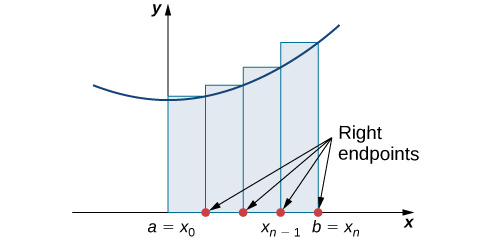
Figure \(\PageIndex{3}\): In the right-endpoint approximation of the area under a curve, the height of each rectangle is determined by the function value at the right of each subinterval. Note that the right-endpoint approximation differs from the left-endpoint approximation in Figure \(\PageIndex{2}\).
The graphs in Figure \(\PageIndex{4}\) represent the curve \(f(x)=\frac{x^2}{2}\). In Figure \(\PageIndex{4a}\), we divide the region represented by the interval \([0,3]\) into six subintervals, each of width \(0.5\). Thus, \( \Delta x=0.5\). We then form six rectangles by drawing vertical lines perpendicular to \(x_{i−1}\), the left endpoint of each subinterval. We determine the height of each rectangle by calculating \(f(x_{i−1})\) for \(i=1, \, 2, \, 3, \, 4, \, 5, \, 6\). The intervals are \([0,0.5], \, [0.5,1], \, [1,1.5], \, [1.5,2], \, [2,2.5], \, [2.5,3]\). We find the area of each rectangle by multiplying the height by the width. Then, the sum of the rectangular areas approximates the area between \(f(x)\) and the \(x\)-axis. When the left endpoints are used to calculate height, we have a left-endpoint approximation. Thus,\[\begin{array}{rcl}
A & \approx & L_6 \\[6pt]
& = & \displaystyle \sum_{i=1}^6f(x_{i−1}) \Delta x \\[6pt]
& = & f(x_0) \Delta x+f(x_1) \Delta x+f(x_2) \Delta x+f(x_3) \Delta x+f(x_4) \Delta x+f(x_5) \Delta x \\[6pt]
& = & f(0)0.5+f(0.5)0.5+f(1)0.5+f(1.5)0.5+f(2)0.5+f(2.5)0.5 \\[6pt]
& = & (0)0.5+(0.125)0.5+(0.5)0.5+(1.125)0.5+(2)0.5+(3.125)0.5 \\[6pt]
& = & 0+0.0625+0.25+0.5625+1+1.5625 \\[6pt]
& = & 3.4375 \,\text{units}^2 \\[6pt]
\end{array} \nonumber \]

Figure \(\PageIndex{4}\): Methods of approximating the area under a curve by using (a) the left endpoints and (b) the right endpoints.
In Figure \(\PageIndex{4b}\), we draw vertical lines perpendicular to \(x_i\) such that \(x_i\) is the right endpoint of each subinterval, and calculate \(f(x_i)\) for \(i=1, \, 2, \, 3, \, 4, \, 5, \, 6\). We multiply each \(f(x_i)\) by \( \Delta x\) to find the rectangular areas and then add them. This is a right-endpoint approximation of the area under \(f(x)\). Thus,\[ \begin{array}{rcl}
A & \approx & R_6 \\[6pt]
& = & \displaystyle \sum_{i=1}^6f(x_i) \Delta x \\[6pt]
& = & f(x_1) \Delta x+f(x_2) \Delta x+f(x_3) \Delta x+f(x_4) \Delta x+f(x_5) \Delta x+f(x_6) \Delta x\\[6pt]
& = & f(0.5)0.5+f(1)0.5+f(1.5)0.5+f(2)0.5+f(2.5)0.5+f(3)0.5 \\[6pt]
& = & (0.125)0.5+(0.5)0.5+(1.125)0.5+(2)0.5+(3.125)0.5+(4.5)0.5 \\[6pt]
& = & 0.0625+0.25+0.5625+1+1.5625+2.25 \\[6pt]
& = & 5.6875 \,\text{units}^2. \\[6pt]
\end{array} \nonumber \]
Example \(\PageIndex{4}\): Approximating the Area Under a Curve
Use both left-endpoint and right-endpoint approximations to approximate the area under the curve of \(f(x)=x^2\) on the interval \([0,2]\); use \(n=4\).
- Solution
-
First, divide the interval \([0,2]\) into \(n\) equal subintervals. Using \(n=4,\, \, \Delta x=\frac{(2−0)}{4}=0.5\). This is the width of each rectangle. The intervals \([0,0.5], \, [0.5,1], \, [1,1.5], \, [1.5,2]\) are shown in Figure \(\PageIndex{5}\). Using a left-endpoint approximation, the heights are \(f(0)=0, \, f(0.5)=0.25, \, f(1)=1\), and \(f(1.5)=2.25\). Then,\[ \begin{array}{rcl}
L_4 & = & f(x_0) \Delta x+f(x_1) \Delta x+f(x_2) \Delta x+f(x_3) \Delta x \\[6pt]
& = & 0(0.5)+0.25(0.5)+1(0.5)+2.25(0.5) \\[6pt]
& = & 1.75 \,\text{units}^2 \\[6pt]
\end{array} \nonumber \]
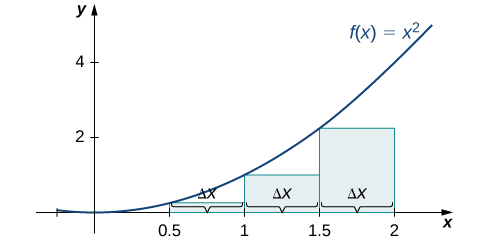
Figure \(\PageIndex{5}\): The graph shows the left-endpoint approximation of the area under \(f(x)=x^2\) from \(0\) to \(2\).
The right-endpoint approximation is shown in Figure \(\PageIndex{6}\). The intervals are the same, \( \Delta x=0.5\), but now use the right endpoint to calculate the height of the rectangles. We have\[ \begin{array}{rcl}
R_4 & = & f(x_1) \Delta x+f(x_2) \Delta x+f(x_3) \Delta x+f(x_4) \Delta x \\[6pt]
& = & 0.25(0.5)+1(0.5)+2.25(0.5)+4(0.5) \\[6pt]
& = & 3.75 \,\text{units}^2 \\[6pt]
\end{array} \nonumber \]
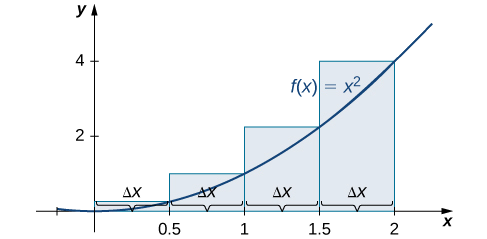
Figure \(\PageIndex{6}\): The graph shows the right-endpoint approximation of the area under \(f(x)=x^2\) from \(0\) to \(2\).
The left-endpoint approximation is \(1.75\,\text{units}^2\); the right-endpoint approximation is \(3.75 \,\text{units}^2\).
Checkpoint \(\PageIndex{4}\)
Sketch left-endpoint and right-endpoint approximations for \(f(x)=\frac{1}{x}\) on \([1,2]\); use \(n=4\). Approximate the area using both methods.
- Answer
-
The left-endpoint approximation is \(0.7595 \,\text{units}^2\). The right-endpoint approximation is \(0.6345 \,\text{units}^2\). See the figures below.

Looking at Figure \(\PageIndex{4}\) and the graphs in Example \(\PageIndex{4}\), we can see that when we use a small number of intervals, neither the left-endpoint approximation nor the right-endpoint approximation is a particularly accurate estimate of the area under the curve. However, increasing the number of points in our partition will improve our estimate of \(A\). We will have more rectangles, but each rectangle will be thinner so we can fit the rectangles to the curve more precisely.
We can demonstrate the improved approximation obtained through smaller intervals with an example. Let's explore the idea of increasing \(n\), first in a left-endpoint approximation with four rectangles, then eight rectangles, and finally \(32\) rectangles. Then, let's do the same thing in a right-endpoint approximation, using the same sets of intervals of the same curved region. Figure \(\PageIndex{7}\) shows the area of the region under the curve \(f(x)=(x−1)^3+4\) on the interval \([0,2]\) using a left-endpoint approximation where \(n=4\). The width of each rectangle is\[ \Delta x=\dfrac{2−0}{4}=\dfrac{1}{2}.\nonumber \] The summed areas of the rectangles approximate the area, or\[L_4=f(0)(0.5)+f(0.5)(0.5)+f(1)(0.5)+f(1.5)0.5=7.5 \,\text{units}^2\nonumber \]

Figure \(\PageIndex{7}\): With a left-endpoint approximation and dividing the region from \(a\) to \(b\) into four equal intervals, the area under the curve is approximately equal to the sum of the areas of the rectangles.
Figure \(\PageIndex{8}\) shows the same curve divided into eight subintervals. Comparing the graph with four rectangles in Figure \(\PageIndex{7}\) with this graph with eight rectangles, we can see there appears to be less white space under the curve when \(n=8\). This white space is the area under the curve we cannot include using our approximation. The area of the rectangles is\[L_8=f(0)(0.25)+f(0.25)(0.25)+f(0.5)(0.25)+f(0.75)(0.25)+f(1)(0.25)+f(1.25)(0.25)+f(1.5)(0.25)+f(1.75)(0.25)=7.75 \,\text{units}^2\nonumber \]
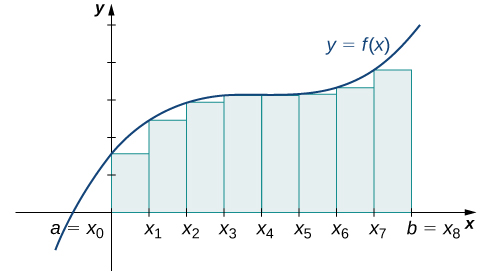
Figure \(\PageIndex{8}\): The region under the curve is divided into \(n=8\) rectangular areas of equal width for a left-endpoint approximation.
The graph in Figure \(\PageIndex{9}\) shows the same function with \(32\) rectangles inscribed under the curve. There appears to be little white space left. The area occupied by the rectangles is\[L_{32}=f(0)(0.0625)+f(0.0625)(0.0625)+f(0.125)(0.0625)+ \cdots +f(1.9375)(0.0625)=7.9375 \,\text{units}^2.\nonumber \]
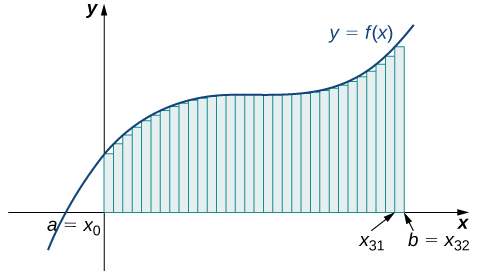
Figure \(\PageIndex{9}\): Here, \(32\) rectangles are inscribed under the curve for a left-endpoint approximation.
We can perform a similar process for the right-endpoint approximation method. A right-endpoint approximation of the same curve, using four rectangles (Figure \(\PageIndex{10}\)), yields an area\[R_4=f(0.5)(0.5)+f(1)(0.5)+f(1.5)(0.5)+f(2)(0.5)=8.5 \,\text{units}^2.\nonumber \]

Figure \(\PageIndex{10}\): Now, we divide the area under the curve into four equal subintervals for a right-endpoint approximation.
Dividing the region over the interval \([0,2]\) into eight rectangles results in \( \Delta x=\frac{2−0}{8}=0.25\). The graph is shown in Figure \(\PageIndex{11}\). The area is\[R_8=f(0.25)(0.25)+f(0.5)(0.25)+f(0.75)(0.25)+f(1)(0.25)+f(1.25)(0.25)+f(1.5)(0.25)+f(1.75)(0.25)+f(2)(0.25)=8.25 \,\text{units}^2\nonumber \]
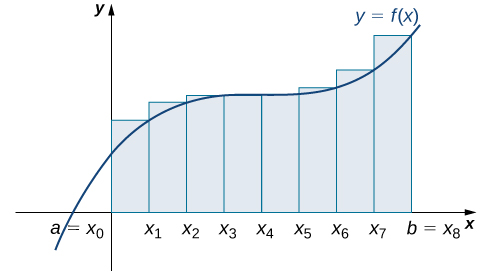
Figure \(\PageIndex{11}\): Here, we use a right-endpoint approximation for a region divided into eight equal subintervals.
Last, the right-endpoint approximation with \(n=32\) is close to the actual area (Figure \(\PageIndex{12}\)). The area is approximately\[R_{32}=f(0.0625)(0.0625)+f(0.125)(0.0625)+f(0.1875)(0.0625)+ \cdots +f(2)(0.0625)=8.0625 \,\text{units}^2\nonumber \]

Figure \(\PageIndex{12}\): The region is divided into \(32\) equal subintervals for a right-endpoint approximation.
Based on these figures and calculations, we are on the right track; the rectangles better approximate the area under the curve as \(n\) gets larger. Furthermore, as \(n\) increases, both the left-end and right-endpoint approximations approach an area of \(8\) square units. Table \(\PageIndex{1}\) shows a numerical comparison of the left- and right-endpoint methods. The idea that the approximations of the area under the curve get better and better as \(n\) gets larger and larger is very important, and we now explore this idea in more detail.
Table \(\PageIndex{1}\): Converging Values of Left- and Right-Endpoint Approximations as \(n\) Increases
| Value of \(n\) |
Approximate Area \(L_n\) |
Approximate Area \(R_n\) |
| \(n=4\) |
\(7.5\) |
\(8.5\) |
| \(n=8\) |
\(7.75\) |
\(8.25\) |
| \(n=32\) |
\(7.94\) |
\(8.06\) |
So far, we have been using rectangles to approximate the area under a curve. The heights of these rectangles have been determined by evaluating the function at either the right or left endpoints of the subinterval \([x_{i−1},x_i]\). In reality, there is no reason to restrict the evaluation of the function to only one of these two points. We could evaluate the function at any point \(x^∗_i\) in the subinterval \([x_{i−1},x_i]\), and use \(f(x^∗_i)\) as the height of our rectangle. This gives us an estimate for the area of the form\[A \approx \sum_{i=1}^nf(x^∗_i)\, \Delta x. \nonumber \]A sum of this form is called a Riemann sum, named for the 19th-century mathematician Bernhard Riemann, who developed the idea.
Definition: Riemann sum
Let \(f(x)\) be defined on a closed interval \([a,b]\) and let \(P\) be any partition of \([a,b]\). Let \( \Delta x_i\) be the width of each subinterval \([x_{i−1},x_i]\) and for each \(i\), let \(x^∗_i\) be any point in \([x_{i−1},\,x_i]\). A Riemann sum is defined for \(f(x)\) as\[\sum_{i=1}^nf(x^∗_i)\, \Delta x_i. \nonumber \]
At this point, we'll choose a regular partition \(P\), as we have in our examples above. This forces all \( \Delta x_i\) to be equal to \( \Delta x = \frac{b-a}{n}\) for any natural number of intervals \(n\).
Recall that with the left- and right-endpoint approximations, the estimates get better and better as \(n\) get larger and larger. The same thing happens with Riemann sums. Riemann sums give better approximations for larger values of \(n\). We are now ready to define the area under a curve in terms of Riemann sums.
Definition: Area Under the Curve
Let \(f(x)\) be a continuous, nonnegative function on an interval \([a,b]\), and let \(\displaystyle \sum_{i=1}^nf(x^∗_i)\, \Delta x\) be a Riemann sum for \(f(x)\) with a regular partition \(P\). Then, the area under the curve \(y=f(x)\) on \([a,b]\) is given by\[A=\lim_{n \to \infty}\sum_{i=1}^nf(x^∗_i)\, \Delta x. \nonumber \]
Some subtleties here are worth discussing. First, taking the limit of a sum is different from taking the limit of a function \(f(x)\) as \(x\) goes to infinity. Limits of sums are discussed in Calculus II; however, we can assume that the computational techniques we used to compute the limits of functions can also be used to calculate the limits of sums.
Second, we must consider what to do if the expression converges to different limits for different choices of \({x^∗_i}\). Fortunately, this does not happen. Although the proof is beyond the scope of this text, it can be shown that if \(f(x)\) is continuous on the closed interval \([a,b]\), then \(\displaystyle \lim_{n \to \infty}\sum_{i=1}^nf(x^∗_i) \Delta x\) exists and is unique (in other words, it does not depend on the choice of \({x^∗_i}\)).
We look at some examples shortly. But, before we do, let's take a moment and talk about some specific choices for \({x^∗_i}\). Although any choice for \({x^∗_i}\) gives us an estimate of the area under the curve, we don't necessarily know whether that estimate is too high (overestimate) or too low (underestimate). If it is important to know whether our estimate is high or low, we can select our value for \({x^∗_i}\) to guarantee one result or the other.
If we want an overestimate, for example, we can choose \({x^∗_i}\) such that for \(i=1, \, 2, \, 3, \, \ldots , \, n\), \(f(x^∗_i) \geq f(x)\) for all \(x \in [x_i−1,x_i]\). In other words, we choose \({x^∗_i}\) so that for \(i=1, \, 2, \, 3, \, \ldots , \, n\), \(f(x^∗_i)\) is the maximum function value on the interval \([x_{i−1},x_i]\). If we select \({x^∗_i}\) in this way, then the Riemann sum \(\displaystyle \sum_{i=1}^nf(x^∗_i) \Delta x\) is called an upper sum. Similarly, if we want an underestimate, we can choose \({x^∗_i}\) so that for \(i=1,2,3, \ldots ,n\), \(f(x^∗_i)\) is the minimum function value on the interval \([x_{i−1},x_i]\). The associated Riemann sum is called a lower sum. Note that if \(f(x)\) is either increasing or decreasing throughout the interval \([a,b]\), then the maximum and minimum values of the function occur at the endpoints of the subintervals, so the upper and lower sums are just the same as the left- and right-endpoint approximations.
Example \(\PageIndex{5}\): Finding Lower and Upper Sums
Find a lower sum for \(f(x)=10−x^2\) on \([1,2]\); let \(n=4\) subintervals.
- Solution
-
With \(n=4\) over the interval \([1,2], \, \Delta x=\frac{1}{4}\). We can list the intervals as \([1,1.25],\,[1.25,1.5],\,[1.5,1.75]\), and \([1.75,2]\). Because the function is decreasing over the interval \([1,2]\), Figure \( \PageIndex{13} \) shows that a lower sum is obtained by using the right endpoints.
![The graph of f(x) = 10 − x^2 from 0 to 2. It is set up for a right-end approximation of the area bounded by the curve and the x-axis on [1, 2], labeled a=x0 to x4. It shows a lower sum.](https://math.libretexts.org/@api/deki/files/4665/5A.png?revision=1)
Figure \(\PageIndex{13}\): The graph of \(f(x)=10−x^2\) is set up for a right-endpoint approximation of the area bounded by the curve and the \(x\)-axis on \([1,2]\), and it shows a lower sum.
The Riemann sum is\[\begin{array}{rcl}
\displaystyle \sum_{k=1}^4(10−x^2)(0.25) & = & 0.25[10−(1.25)^2+10−(1.5)^2+10−(1.75)^2+10−(2)^2] \\[6pt]
& = & 0.25[8.4375+7.75+6.9375+6] \\[6pt]
& = & 7.28 \,\text{units}^2. \\[6pt]
\end{array} \nonumber \]The area of \(7.28\) \(\text{units}^2\) is a lower sum and an underestimate.
Checkpoint \(\PageIndex{5}\)
- Find an upper sum for \(f(x)=10−x^2\) on \([1,2]\); let \(n=4\).
- Sketch the approximation.
- Answer
-
- Upper sum=\(8.0313 \,\text{units}^2\).
-
![A graph of the function f(x) = 10 − x^2 from 0 to 2. It is set up for a right endpoint approximation over the area [1,2], which is labeled a=x0 to x4. It is an upper sum.](https://math.libretexts.org/@api/deki/files/4666/15.png?revision=1)
Example \(\PageIndex{6}\): Finding Lower and Upper Sums for \(f(x)=\sin x\)
Find a lower sum for \(f(x)=\sin x\) over the interval \([a,b]=\left[0,\frac{\pi}{2} \right]\); let \(n=6\).
- Solution
-
Let's first look at the graph in Figure \(\PageIndex{14}\) to get a better idea of the area of interest.

Figure \(\PageIndex{14}\): The graph of \(y=\sin x\) is divided into six regions: \( \Delta x=\frac{\pi/2}{6}=\frac{\pi}{12}\).
The intervals are \(\left[0,\frac{\pi}{12}\right],\,\left[\frac{\pi}{12},\frac{\pi}{6}\right],\,\left[\frac{\pi}{6},\frac{\pi}{4}\right],\,\left[\frac{\pi}{4},\frac{\pi}{3}\right],\,\left[\frac{\pi}{3},\frac{5\pi}{12}\right]\), and \(\left[\frac{5\pi}{12},\frac{\pi}{2}\right]\). Note that \(f(x)=\sin x\) is increasing on the interval \(\left[0,\frac{\pi}{2}\right]\), so a left-endpoint approximation gives us the lower sum. A left-endpoint approximation is the Riemann sum \(\sum_{i=0}^5\sin x_i\left(\tfrac{\pi}{12}\right)\).We have\[A \approx \sin(0)\left(\tfrac{\pi}{12}\right)+\sin\left(\tfrac{\pi}{12}\right)\left(\tfrac{\pi}{12}\right)+\sin\left(\tfrac{\pi}{6}\right)\left(\tfrac{\pi}{12}\right)+\sin\left(\tfrac{\pi}{4}\right)\left(\tfrac{\pi}{12}\right)+\sin\left(\tfrac{\pi}{3}\right)\left(\tfrac{\pi}{12}\right)+\sin\left(\tfrac{5\pi}{12}\right)\left(\tfrac{\pi}{12}\right)\approx 0.863 \,\text{units}^2. \nonumber \]
Checkpoint \(\PageIndex{6}\)
Using the function \(f(x)=\sin x\) over the interval \(\left[0,\frac{\pi}{2}\right]\), find an upper sum; let \(n=6\).
- Answer
-
\(A \approx 1.125 \,\text{units}^2\)

















![The graph of f(x) = 10 − x^2 from 0 to 2. It is set up for a right-end approximation of the area bounded by the curve and the x-axis on [1, 2], labeled a=x0 to x4. It shows a lower sum.](https://math.libretexts.org/@api/deki/files/4665/5A.png?revision=1)
![A graph of the function f(x) = 10 − x^2 from 0 to 2. It is set up for a right endpoint approximation over the area [1,2], which is labeled a=x0 to x4. It is an upper sum.](https://math.libretexts.org/@api/deki/files/4666/15.png?revision=1)
